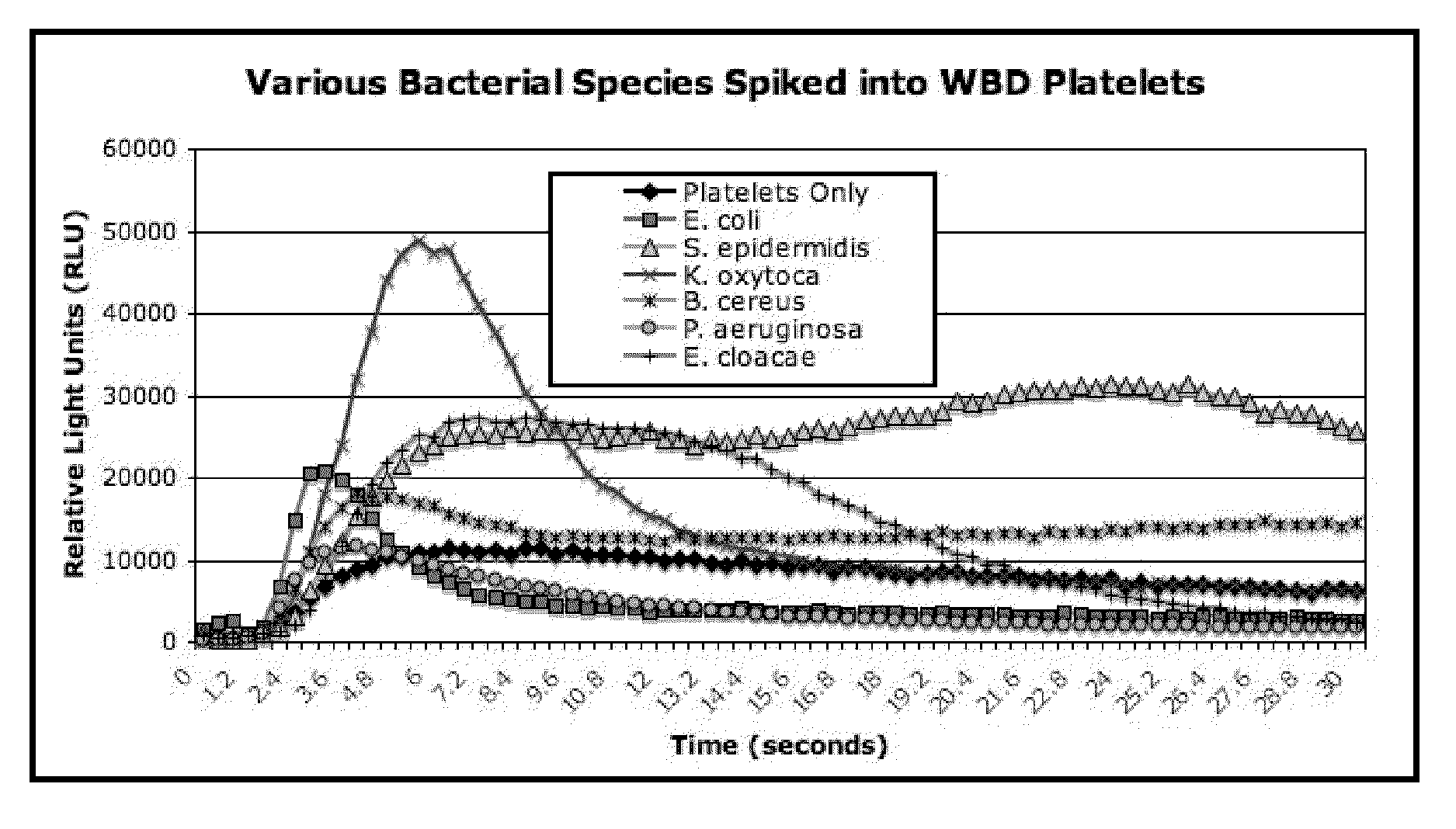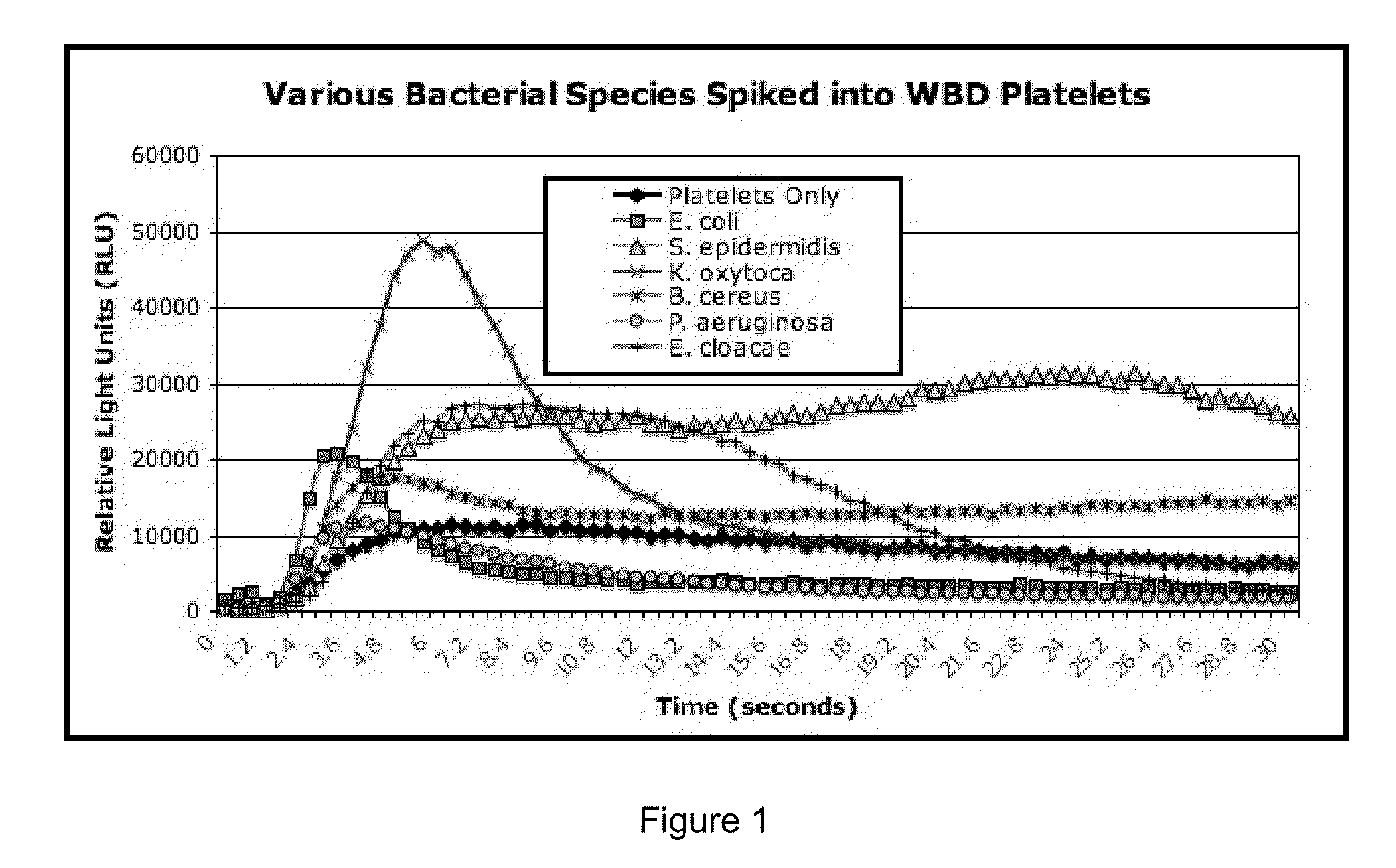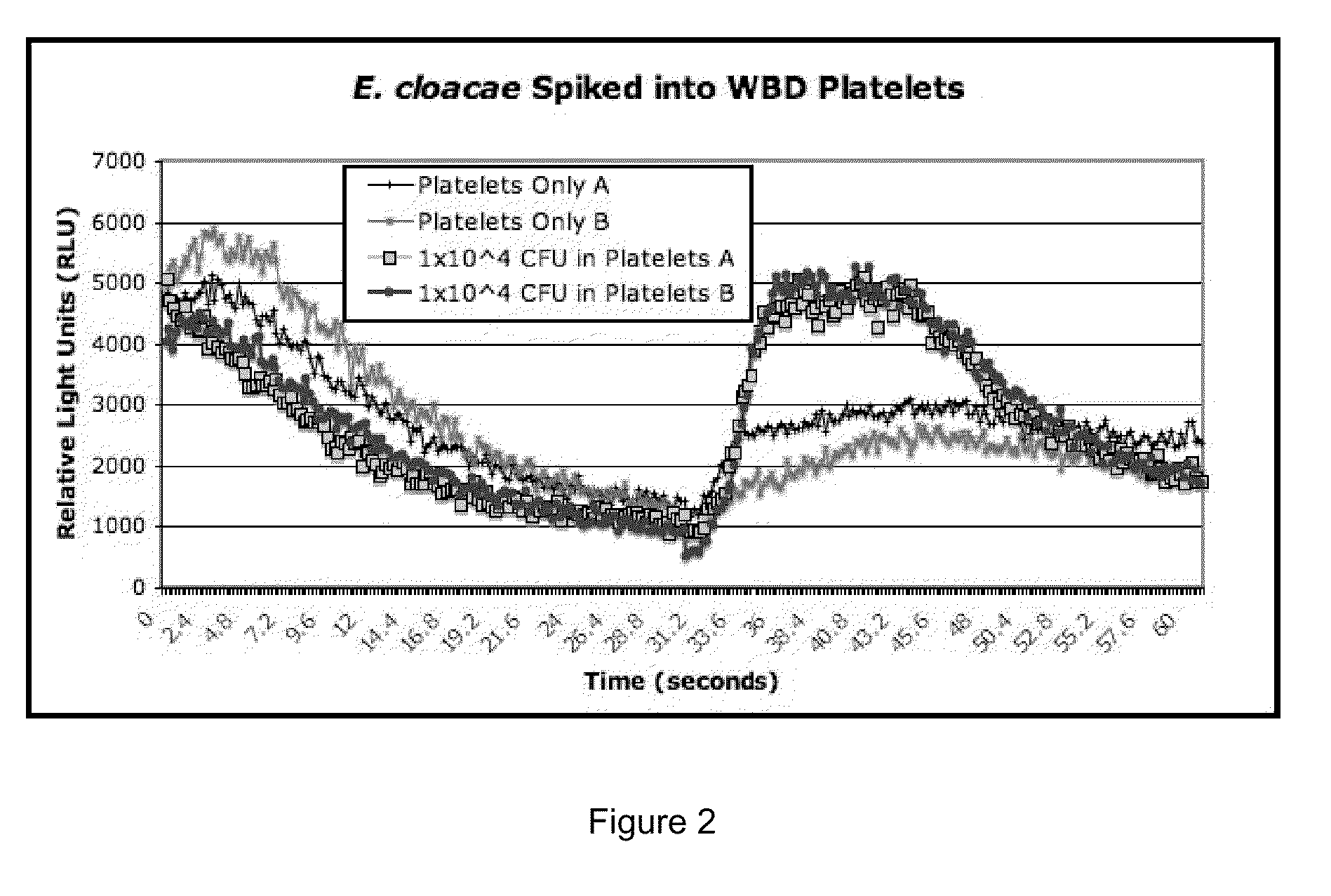Methods and kits for the rapid detection of microorganisms
a technology for microorganisms and detection kits, applied in the field of analytical methods, can solve the problems of bacterial contamination of platelets, no current single detection technique is suitable for both types of platelets, and is susceptible to serious contamination. , to achieve the effect of robust, rapid and sensitive detection of bacterial contamination
- Summary
- Abstract
- Description
- Claims
- Application Information
AI Technical Summary
Benefits of technology
Problems solved by technology
Method used
Image
Examples
example 1
Bacterial Detection in Whole Blood-Derived and Apheresis Platelet Concentrates Using ATP Luminescence
[0174]This example demonstrates that bacteria may be rapidly detected in platelet concentrates according to the methods of the present invention. Platelet concentrates were spiked with different amounts of various bacterial species as described below, and bacteria was detected in platelet concentrates using the following materials and protocol.
[0175]Materials:
[0176]1.7 mL Costar micro-centrifuge tubes
[0177]Lysis reagent, 0.16% v / v Triton X-100 (Reagent A)
[0178]Micro-centrifuge
[0179]Filter-sterile diH2O
[0180]Succinate Buffer, pH 6.5 with 0.3% BSA
[0181]Apyrase (Sigma A6535) at 495 Units / mL in diH2O
[0182]Timer
[0183]Berthold Sirius luminometer
[0184]GenPrime microtube Adapter (GenPrime, Spokane, Wash., USA)
[0185]BacTiter-Glo™ Buffer Standard Reagent (Promega Corp., Madison, Wis., USA)
[0186]BacTiter-Glo™ Substrate (Promega Corp., Madison, Wis., USA)
[0187]BacTiter-Glo GenPrime Custom Reagen...
example 2
Bacterial Detection in Finished Beer Products Using ATP Luminescence
[0220]This example demonstrates that bacteria may be rapidly detected in finished beer products according to the methods of the present invention. Beer was spiked with different amounts of bacteria as described below, and bacteria were detected in the beer using the following materials and protocol.
[0221]Materials:
[0222]1.7 mL Costar Micro-centrifuge Tubes
[0223]Micro-centrifuge
[0224]Filter-sterile diH2O
[0225]Timer
[0226]Berthold Sirius Luminometer
[0227]GenPrime Microtube Adapter (GenPrime, Spokane, Wash., USA)
[0228]BacTiter-Glo™ Buffer (Promega Corp., Madison, Wis., USA)
[0229]BacTiter-Glo™ Substrate (Promega Corp., Madison, Wis., USA)
[0230]GenPrime Custom Buffer (GenPrime, Spokane, Wash., USA)
[0231]GenPrime BacSTAT Software (GenPrime, Spokane, Wash., USA)
[0232]Protocol:
[0233]Rehydrate one vial of BacTiter-Glo™ Substrate with 10 mL of GenPrime Custom Buffer to create Custom Reagent.
[0234]Rehydrate one vial of BacTiter...
example 3
Bacterial Detection in Fermenting Corn Mash Using ATP Luminescence
[0250]This example demonstrates that bacteria may be rapidly detected in fermenting corn mash according to the methods of the present invention. Fermenting corn mash was spiked with different amounts of bacteria as described below, and bacteria were detected in the corn mash using the following materials and protocol.
[0251]Materials:
[0252]50 mL centrifuge tube
[0253]Swiss Gold coffee (SGC) filter
[0254]400 mL beaker
[0255]Stirring spoon
[0256]Microcon® (5 um pore size) Centrifugal Filter Tubes
[0257]Transfer Pipettes
[0258]Succinate Buffer, pH 6.5 with 0.3% BSA
[0259]Apyrase (Sigma A6535) at 495 Units / mL in diH2O
[0260]Timer
[0261]MicroCentrifuge
[0262]Berthold Sirius Luminometer
[0263]GenPrime Microtube Adapter (GenPrime, Spokane, Wash., USA)
[0264]BacTiter-Glo™ Buffer Standard Reagent (Promega Corp., Madison, Wis., USA)
[0265]BacTiter-Glo™ Substrate (Promega Corp., Madison, Wis., USA)
[0266]GenPrime Custom Buffer (GenPrime, Spoka...
PUM
 Login to View More
Login to View More Abstract
Description
Claims
Application Information
 Login to View More
Login to View More - R&D
- Intellectual Property
- Life Sciences
- Materials
- Tech Scout
- Unparalleled Data Quality
- Higher Quality Content
- 60% Fewer Hallucinations
Browse by: Latest US Patents, China's latest patents, Technical Efficacy Thesaurus, Application Domain, Technology Topic, Popular Technical Reports.
© 2025 PatSnap. All rights reserved.Legal|Privacy policy|Modern Slavery Act Transparency Statement|Sitemap|About US| Contact US: help@patsnap.com



